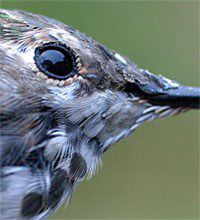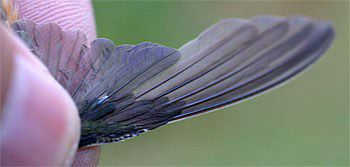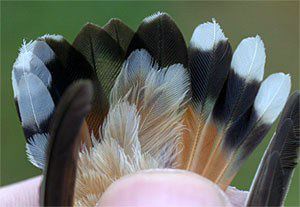 HOME: www.hiltonpond.org |
|||
|
RUFOUS HUMMINGBIRD |
|
Vaughn Morrison and his wife Beth live almost at the top of Laurel Mountain, a 4,000-foot peak in Ashe County not far from Boone. From their back deck they look out across the Blue Ridge and--probably because of Beth's Salvia plantings--were able to catch the eye of an unusual hummer after their Ruby-throated Hummingbirds left for the season. Vaughn first noticed a hummer with rust in its tail on 16 October and after learning of our work with vagrant hummingbirds called to leave a message on 24 October.  Due to other commitments we had to postpone a trip to Todd for a few days, but at 4 a.m. on 26 October we packed up our banding equipment and portable trap and aimed our van up U.S. 321 toward the Morrison residence. Two-and-a-quarter hours later we climbed the last long hill to the ridgetop and were greeted warmly by Vaughn in the overcast, windy, pre-dawn darkness.
We quickly moved Vaughn's hummingbird feeder into our trap and hung the apparatus on the back deck where his mysterious hummingbird had been dining. Within a few minutes the bird arrived, investigated our device, and went in with no trepidation. We quickly hit the remote button for the electronic door closer and--as sometimes occurs with these contraptions--nothing happened. The hummer continued to feed as we continually pushed the button and then left when we opened the glass door to the deck to check the trap. Drat! Vaughn's initial observations of a bird with rusty-based tail were obviously correct, making this a Selasphorus hummingbird-- either a Rufous (S. rufus) or the similar-looking but somewhat smaller Allen's (S. sasin). The bird seemed large, and we suspected not only that it was a Rufous but also a female, since males are about 20-25% smaller. In-hand measurements (see "Vital Statistics" below) validated our suspicions on both counts--even though the bird had six iridescent orange-red gorget feathers (top photo). Unlike Ruby-throated Hummingbirds in which only males bear metallic throat plumage, Selasphorus females usually have one to many of these bright feathers.
After banding and measurements were complete, we took the bird outside for a few photos and to insert its bill into the feeder. It drank readily, so we placed it in Beth Morrison's hand (below right), where it sat quietly for a few minutes before zipping off across the valley.  Vital Statistics for Vital Statistics forRufous Hummingbird #Y14849 Age/Sex--Hatch-year female Weight--3.60g Wing Chord--45.9mm Tail Length--27.0mm Tail Fork--4.0mm Culmen (upper bill)--18.5mm Bill Corrugations--Thin line of etchings along 60% of bill Gorget--Six orange-red metallic feathers Molt--#5 primary feather in partial quill; pin feathers on chin & forehead Thanks to Vaughn for contacting us with the report of this Rufous Hummingbird, and to Beth for her enthusiasm and great questions. We suspect Beth will be planting even more Salvia next spring as the Morrisons try to draw in another winter vagrant hummingbird in 2004--or a few more this year. POSTSCRIPT: On 7 November 2003 we returned to the Morrison residence and trapped a second hatch-year female Rufous Hummingbird.
If you're interested in sharing your hummingbird observations and learning from other enthusiasts, you may wish to subscribe to Hummingbird Hobnob, our Yahoo!-based discussion group. Also be sure to visit our award-winning Web site for Operation RubyThroat: The Hummingbird Project; on it you'll find almost anything you want to know about hummingbirds, including more information about Hummingbird Banding.
For much more information about hummingbirds, visit Operation RubyThroat: The Hummingbird Project  |
 One nice thing about banding vagrant hummingbirds is that we get to meet interesting people, and even get reacquainted with old friends. Over a seven-day span in late October 2003, we traveled to
One nice thing about banding vagrant hummingbirds is that we get to meet interesting people, and even get reacquainted with old friends. Over a seven-day span in late October 2003, we traveled to 
 Seems that one of the electrical wires had jiggled loose on the way up the mountain, so we re-attached it and went inside the house to wait. Fortunately, the bird came back within ten minutes, and again entered the trap almost immediately. This time there was no mechanical failure, and before the sun was even up we had the bird in hand.
Seems that one of the electrical wires had jiggled loose on the way up the mountain, so we re-attached it and went inside the house to wait. Fortunately, the bird came back within ten minutes, and again entered the trap almost immediately. This time there was no mechanical failure, and before the sun was even up we had the bird in hand. Of greater difficulty than sexing the bird was determining its age. At first we thought the Morrisons' bird might be an adult hatched out prior to 2003, mostly because of the size and number of the gorget feathers, feather molt on the right cheek, new pin feathers on the chin and forehead (above left), and a #5 primary feather whose base was still ensheathed (above right). It's very unusual to see such extensive molt so early in the fall among wandering Rufous Hummingbirds unless they are adults, so we were about to conclude it couldn't be a hatch-year bird.
Of greater difficulty than sexing the bird was determining its age. At first we thought the Morrisons' bird might be an adult hatched out prior to 2003, mostly because of the size and number of the gorget feathers, feather molt on the right cheek, new pin feathers on the chin and forehead (above left), and a #5 primary feather whose base was still ensheathed (above right). It's very unusual to see such extensive molt so early in the fall among wandering Rufous Hummingbirds unless they are adults, so we were about to conclude it couldn't be a hatch-year bird.  However, after looking carefully at the hummer's bill with a hand lens, we found there was a thin line of tiny corrugations (etchings) along 60% of its length; these marks wear off or fill in over several months so that an adult bird's tends to be very smooth and unetched. In the end, the corrugations--along with the shape and texture of the somewhat worn tail feathers (above left)--led us to record it as a bird that hatched this year, undoubtedly somewhere in southern Alaska, western Canada, or the northern Rocky Mountain states.
However, after looking carefully at the hummer's bill with a hand lens, we found there was a thin line of tiny corrugations (etchings) along 60% of its length; these marks wear off or fill in over several months so that an adult bird's tends to be very smooth and unetched. In the end, the corrugations--along with the shape and texture of the somewhat worn tail feathers (above left)--led us to record it as a bird that hatched this year, undoubtedly somewhere in southern Alaska, western Canada, or the northern Rocky Mountain states.

 Students at GLOBE-certified schools may submit winter hummingbird observations as part of Operation RubyThroat and GLOBE. Students can also correlate hummingbird observations with data on abiotic factors, including atmosphere, climate, hydrology, soils, land cover, and phenology. See the
Students at GLOBE-certified schools may submit winter hummingbird observations as part of Operation RubyThroat and GLOBE. Students can also correlate hummingbird observations with data on abiotic factors, including atmosphere, climate, hydrology, soils, land cover, and phenology. See the 


